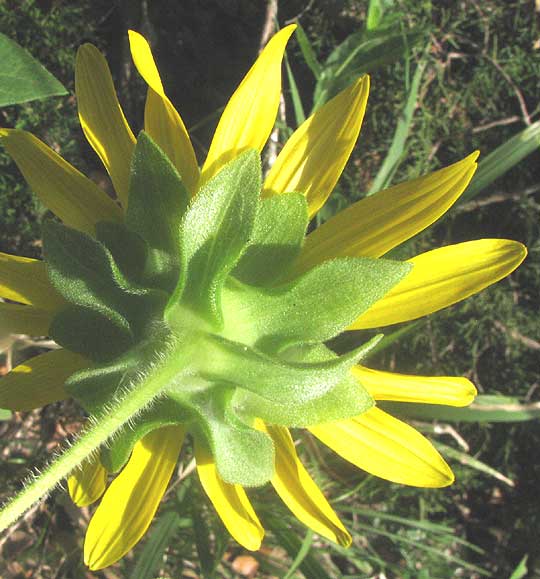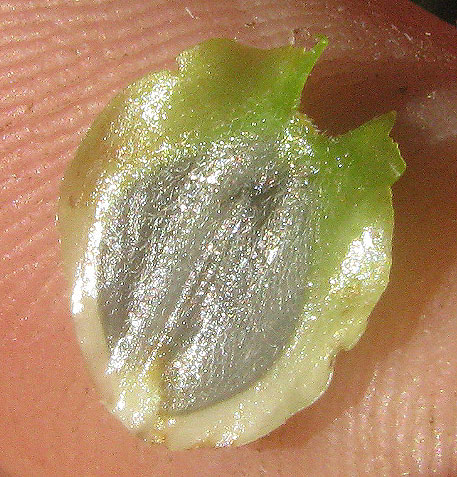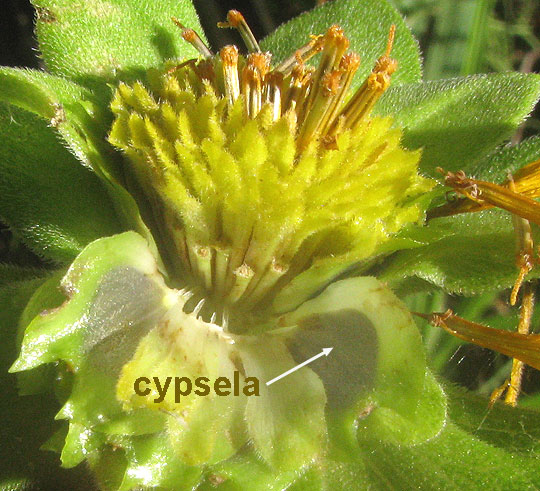Excerpts from Jim Conrad's
Naturalist Newsletter

from the August 18, 2013 Newsletter issued from the Frio Canyon Nature Education Center in the valley of the Dry Frio River in northern Uvalde County, southwestern Texas, on the southern border of the Edwards Plateau; elevation ~1750m (~5750 ft); N29.62°, W99.86°; USA
STARRY ROSINWEED
On a steep, somewhat shaded, lower slope beside the Dry Frio River a certain yellow-flowered member of the Composite or Sunflower Family displayed flowering heads about three inches across (7.5cm). The heads stood atop a stem bearing substantial leaves occurring at stem nodes both singularly and in pairs (both alternate and opposite leaves), as shown above.
Back East in late summer and fall several similar species can be encountered, mostly sunflowers in the genus Helianthus, but here it's so arid that it's unusual to encounter such broadleved, large-flowered Composites, and this species stands out. Moreover, when I looked at the involucre below the head, its bracts, or phyllaries, didn't look like those of the sunflowers, as you can see below:

For one thing, most sunflower phyllaries are rough hairy while these are practically hairless, or "glabrous," except for short cilia along the margins. Also, I don't recall seeing sunflower phyllary edges folding downward and "pinching together" like these.
In sunflower heads, only the tiny, cylindrical disc florets forming the heads' eyes produce fruits -- which we think of sunflower "seeds." The sunflower's petal-like ray florets -- the ones radiating from the eye -- are "neuter" and produce no fruits. Checking these details on our plant, I bent down one side of a head and found exactly the opposite of what would be found in a sunflower: Ray florets produced fruits, but disc florets were sterile.
But before looking at that, you might want to see what our plant's cypsela-type fruit looks like. Here's one that tumbled from the head as I bent down one of the head's sides:

That fruit, or cypsela, is thin and flat like a dislodged fingernail. Notice the thin, greenish "wings" on both sides of the dark center, which holds the actual seed. The notch at the top, right is where the base of the ray floret corolla was attached before it fell off, after the flower was pollinated. This flat, fingernail-like fruit obviously is very different from sunflower fruits, which people think of as sunflower "seeds." Now in the picture below locate our wildflower's large, winged, cypsela-type fruit in the head where I bent down one side:

Those large cypselae were produced only at the flower heads' margins at the bases of ray floret corollas. At the bottom of the cluster of disc florets forming the head's "eye" you can see where several cylindrical disc-floret corollas have fallen off, leaving behind runty, aborted ovaries that will not develop into fruits.
Only a few genera in the vast Composite or Sunflower Family produce flowering heads in which the disc florets forming the eye produce no fruits, but the petal-like ray florets do. Maybe the best known of those that do are the rosinweeds. In fact, our slope-living Composite turns out to be the Starry Rosinweed, SILPHIUM ASTERISCUS, a species occupying much of the eastern US, except for New England; with us the species appears at its southwesternmost point of distribution.
Other rosinweed species can turn up in our area. Among the details distinguishing our plant from those are: its broader leaves whose bases don't grow around, or clasp, the stem; the leaves with either a short petiole or none at all, and; the heads bearing relatively few ray flowers -- mostly 12-17.
The online Flora of North America recognizes five varieties of the Starry Rosinweed. Ours is the typical one, Silphium asteriscus var. asteriscus, whose preferred habitat is described as "Prairies, meadows, open forests, roadsides." The Flora also makes clear that there's been a great deal of confusion about rosinweed names, and maybe there still is. In your wildflower book Starry Rosinweed may go by another name.
Classical literature sometimes refers to a famous Silphium plant producing a resin serving as a rich seasoning and a powerful medicine. That Silphium was a different plant, however, probably of the genus Ferula, maybe a "giant fennel." Stems of some of our rosinweed species of the genus Silphium also exude a bit a resin, which accounts for Linnaeus in 1753 naming the genus Silphium after the classic plant, but our Starry Silphium doesn't seem to produce resin.